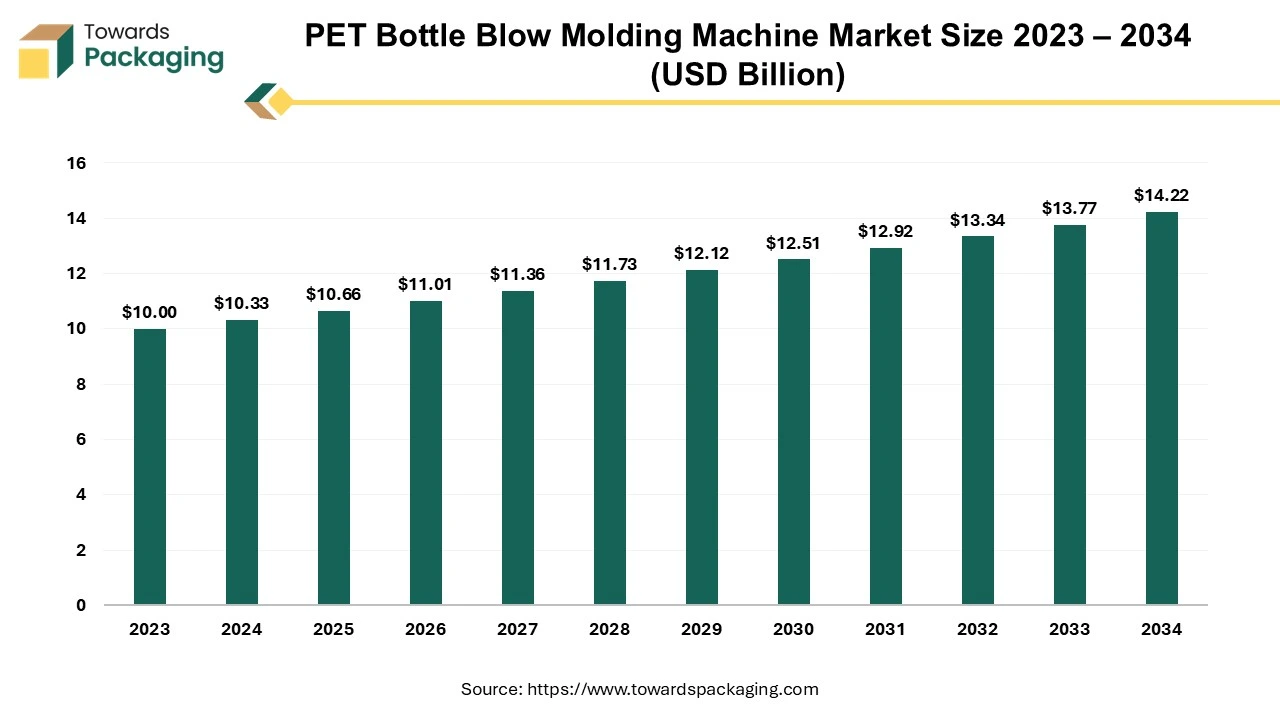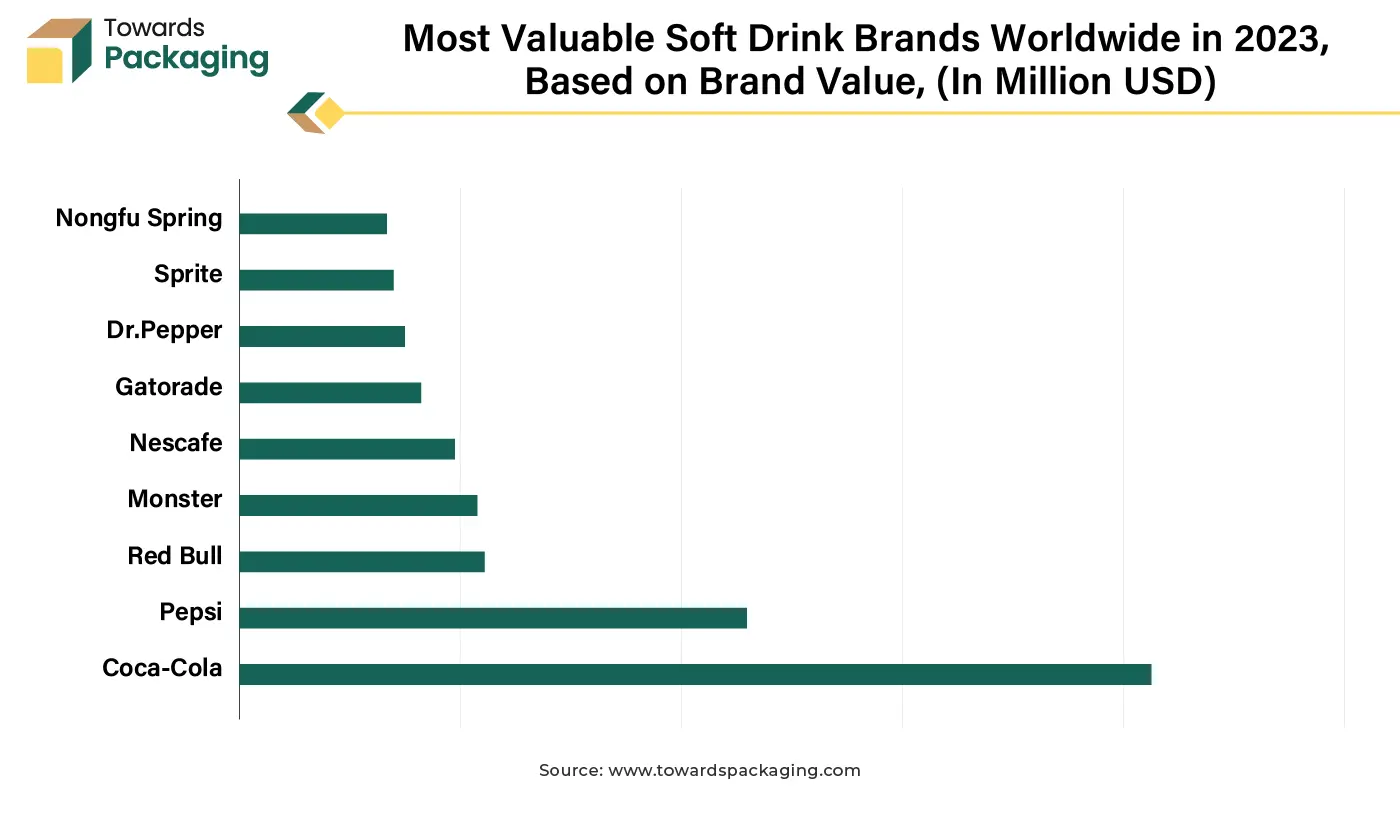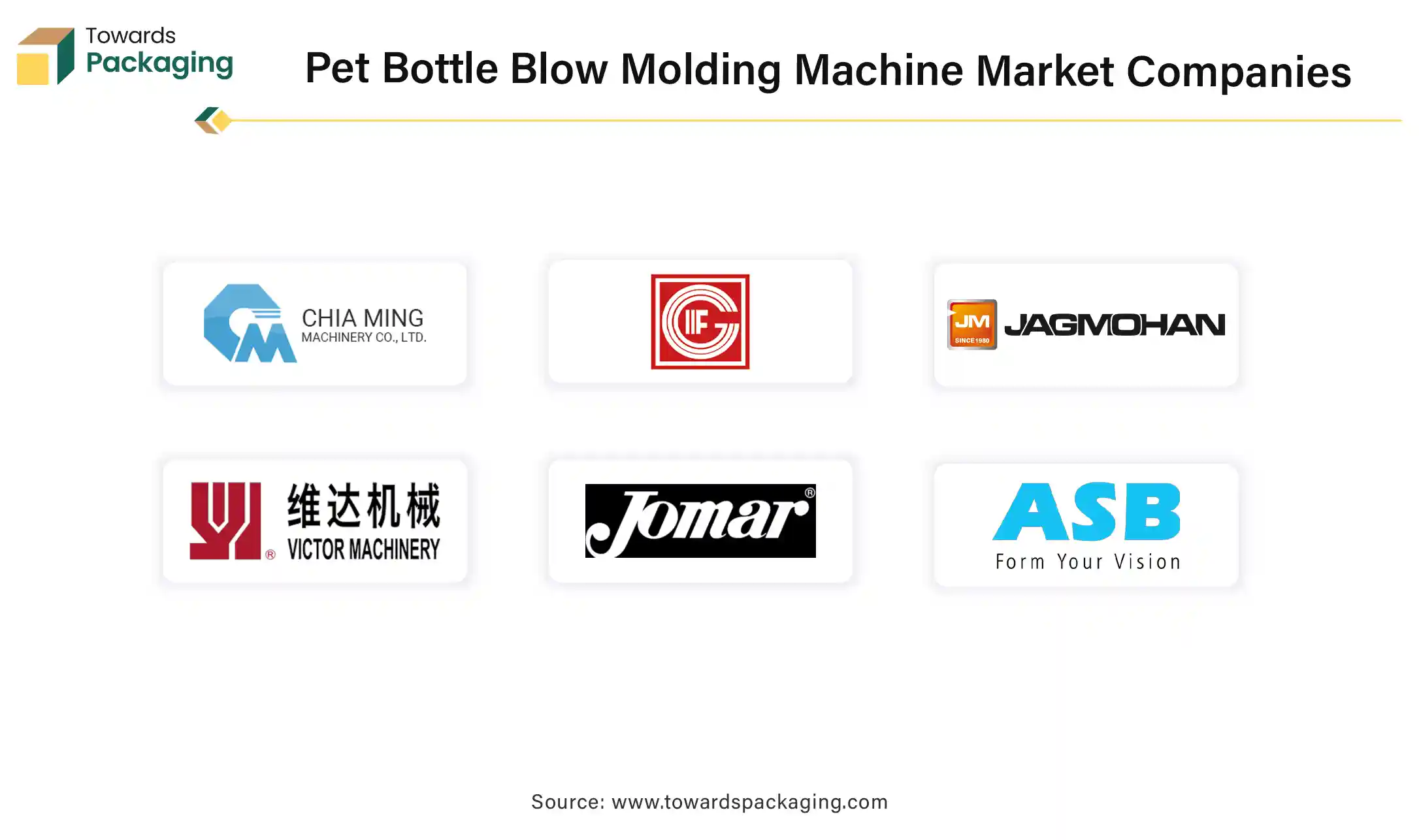February 2025
The global PET bottle blow molding machine market was valued at USD 10.33 billion in 2024 and is projected to reach USD 14.22 billion by 2034, expanding at a CAGR of 3.25% from 2025 to 2034.

Unlock Infinite Advantages: Subscribe to Annual Membership
A PET bottle blow molding machine is a type of manufacturing equipment used to produce plastic bottles manufactured from polyethylene terephthalate (PET). PET is an extensively utilized plastic, especially in the production of beverage and water bottles due to its clarity, durability, and ability to be molded into various shapes.
Automation is becoming more widespread, with machines integrating Industry 4.0 technologies like AI (Artificial Intelligence), IoT (Internet of Things), and data analytics. These technologies allow for real-time monitoring, predictive maintenance, and process optimization, improving efficiency and reducing downtime. Robotic arms and automated systems are being used for handling, packaging, and sorting bottles, minimizing manual labor and increasing production speed.
Rising shift towards using recycled PET material in the production of bottles. Blow molding machines are being designed to handle rPET more efficiently, assisting brands meet sustainability targets by using recycled content in their products.
The trend towards lightweighting PET bottles (reducing the amount of plastic used) is gaining momentum. Machines are being developed to create thinner, yet strong bottles that reduce the environmental footprint without compromising quality. New blow molding machines are designed with energy-saving features, such as reduced power consumption, to align with eco-conscious manufacturing practices and help companies reduce their carbon footprint.
Manufacturers are pushing for faster production times to meet the growing demand for PET bottles. New machines are being built with improved cycle times, allowing for more bottles to be produced in less time. Blow molding machines are evolving to accommodate multi-cavity systems, enabling them to produce more bottles simultaneously. This significantly increases productivity and reduces per-unit costs.
Advanced sensors and AI-based monitoring systems are being integrated into blow molding machines to track parameters like temperature, pressure, and mold performance in real time. This helps in optimizing the production process and ensuring consistent quality. IoT-enabled machines can predict mechanical failures or maintenance needs before they occur, preventing unplanned downtime and reducing operational costs.
As demand for customized packaging grows, blow molding machines are being developed to produce PET bottles in more complex and diverse shapes. This allows brands to differentiate their products with unique packaging designs. New technologies in mold design and manufacturing allow for higher precision in producing intricate and detailed bottle shapes and sizes, accommodating consumer preferences for customization.
The utilization of bio-based PET made from renewable resources (like sugarcane) is on the rise. Blow molding machines are being adapted to handle these new materials, which offer a more sustainable alternative to traditional petroleum-based PET. The development of biodegradable PET alternatives is prompting the industry to innovate blow molding machines that can handle these new, eco-friendly materials.
The concept of creating a digital twin of blow molding machines, where a virtual model mirrors the physical machine’s operation, is being implemented. This allows for better analysis of machine performance, process optimization, and predictive troubleshooting. The collection and analysis of large amounts of production data help manufacturers optimize operations, reduce waste, and improve product quality. Data-driven insights are increasingly being used to guide decision-making in the PET bottle production process.
New PET bottle blow molding machines come equipped with advanced inspection systems that can detect defects in real-time, ensuring higher quality control. This includes automated visual inspection systems that check for bottle defects, such as cracks, improper sealing, or uneven surfaces. Advances in machine technology allow for more precise control over the thickness of the bottle walls, which improves strength, quality, and performance while reducing material waste.
Some manufacturers are combining different types of molding technologies (such as injection molding and stretch blow molding) in a single machine to produce a wider range of bottle types. These hybrid systems offer greater flexibility and faster production capabilities for manufacturers. Advanced machines that perform multiple stages of molding in a single cycle are becoming more common. These machines can produce complex bottle designs in a streamlined process, saving time and reducing the risk of errors.
AI-powered predictive maintenance uses machine learning algorithms to analyze data from sensors on the machines. By predicting potential failures before they happen, manufacturers can schedule maintenance proactively, reducing unplanned downtime. This ensures higher uptime and maximizes production capacity. Early detection of equipment issues can prevent expensive repairs and extend the lifespan of machines, leading to cost savings for manufacturers. AI can continuously monitor the blow molding process, making real-time adjustments to variables like temperature, pressure, and mold positioning to optimize production conditions. This ensures that each bottle is produced with consistent quality, improving yield and reducing waste.
AI can analyze energy usage patterns and recommend adjustments to the machine settings, leading to energy savings and lower operational costs, which is particularly important for sustainability efforts in the industry. AI-driven computer vision systems can inspect every bottle produced in real-time, identifying defects such as cracks, irregular shapes, or poor molding. This reduces the risk of defective products reaching the market, ensuring higher product quality and reducing waste. AI-powered collaborative robots (cobots) can work alongside human operators on production lines, enhancing efficiency, flexibility, and precision while maintaining safety standards.
The rising consumption of bottled water, carbonated soft drinks, juices, and energy drinks is a significant driver. PET bottles are lightweight, cost-effective, and recyclable, making them popular in the beverage industry.

In 2024, according to the data published by International Council of Beverages Associations, certain market categories, such ready-to-drink (RTD) beverages and sparkling water, are expanding quickly in addition to the beverage industry as a whole. With a compound annual growth rate of 6.06%, the RTD beverage industry is expected to reach USD 1,227.81 billion by 2032 from roughly USD 732.49 billion in 2023. The beverage industry in the Asia-Pacific area is expanding due in part to the growing popularity of sparkling water as customers look for healthier substitutes for sugary drinks.
The key players operating in the market are facing issue due to volatile raw material and trade barriers & supply chain disruptions, which has estimated to restrict the growth of the PET bottle blow molding machine market in the near future. PET resin prices are linked to crude oil, and fluctuations in oil prices can affect production costs and profit margins. Tariffs, import/export restrictions, and disruptions in global supply chains (e.g., due to pandemics or geopolitical conflicts) can impact the availability and affordability of machinery and components. Blow molding machines consume significant energy, leading to high operational costs that may hinder adoption in regions with expensive or unreliable energy sources.
Urban population growth and busy lifestyles are fueling the demand for on-the-go beverage packaging, increasing the need for PET bottles and the machines to produce them. Growing urban populations lead to increased consumption of packaged goods due to the convenience they offer, especially in densely populated cities. PET bottles are a preferred choice for beverages such as water, soft drinks, and juices. The rise in on-the-go consumption habits and preference for ready-to-drink products creates a steady demand for PET bottle packaging. As people in urban areas adopt healthier lifestyles, there is an increase in demand for sports drinks, bottled water, and health beverages, which are typically packaged in PET bottles.
Beyond beverages, PET bottles are increasingly used in industries like cosmetics, pharmaceuticals, and household products, further boosting demand for blow molding machines.
The injection blow segment held a dominant presence in the PET bottle blow molding machine market in 2024. Injection blow molding machines ensure uniform wall thickness and precise dimensional accuracy, which are critical for PET bottles used in industries like food, beverages, and pharmaceuticals. The process combines injection molding and blow molding into a single cycle, reducing production time and increasing output rates. Injection blow molding machines can create complex shapes, sizes, and designs, accommodating a wide range of bottle requirements for various industries.
Injection blow molding machine allows for minimal material wastage and efficient use of PET resins, which are critical for cost-effective production. PET bottles produced with injection blow molding machine machines have smooth surfaces and clear finishes, which enhance the appearance and functionality of the final product. The process results in bottles with excellent mechanical properties, including high impact resistance and durability, making them ideal for transportation and storage.
The extrusion blow molding (EBM) segment is expected to grow at the fastest rate in the PET bottle blow molding machine market during the forecast period of 2024 to 2034. Extrusion blow molding (EBM) machines are extensively used in the manufacturing of PET bottle blow molding machines for several reasons, primarily related to their efficiency, versatility, and suitability for certain types of products.
Extrusion blow molding machines excel at creating bottles with complex designs, including handles, asymmetrical shapes, and varying wall thicknesses, which are difficult to achieve with other processes. Extrusion blow molding machines are ideal for producing larger bottles and containers, such as those used for water coolers, detergent bottles, and other industrial applications, where PET is a preferred material.
Advanced extrusion blow molding machines can be equipped with parison programming, which optimizes the thickness of the molten tube, reducing material wastage during production. Compared to injection stretch blow molding (ISBM) machines, EBM machines have a lower initial investment cost, making them an attractive option for small- and medium-scale manufacturers.
The single stage segment accounted for a significant share of the PET bottle blow molding machine market in 2024. Single-stage machines combine injection molding (to create the preform) and blow molding (to form the final bottle) in a single, continuous process. This eliminates the need for transferring preforms between separate machines, reducing handling and contamination risks. These machines ensure precise control over the entire production cycle, resulting in consistent wall thickness, bottle dimensions, and superior product quality—ideal for industries requiring strict quality standards (e.g., food, beverages, and pharmaceuticals). Single-stage blow molding machines are widely used for manufacturing PET bottles due to their streamlined process and efficiency in producing high-quality bottles.
Single-stage machines are ideal for small- to medium-scale production and can handle a wide range of bottle shapes, sizes, and designs. This makes them suitable for manufacturing specialized or customized bottles. In a single-stage process, preforms are directly blown into bottles without the need for intermediate storage. This reduces inventory management costs and minimizes material handling risks.
The food and beverage company segment led the global PET bottle blow molding machine market. The food and beverage industry heavily relies on PET bottles for packaging products such as water, carbonated drinks, juices, ready-to-drink beverages, and edible oils. As this industry expands, the demand for PET bottles increases, fueling the need for blow molding machines. PET bottles are lightweight, durable, and portable, making them a preferred packaging choice for on-the-go consumers. This growing trend in convenience packaging, driven by the food and beverage industry, boosts the market for blow molding machines.
As consumer preferences shift toward ready-to-eat and ready-to-drink products, the demand for efficient, attractive, and sustainable PET bottle packaging grows, spurring investments in advanced blow molding machines.
The food and beverage industry is increasingly prioritizing sustainability, leading to a rise in the use of recyclable PET bottles. Manufacturers of blow molding machines are responding with innovations for producing lightweight, eco-friendly bottles, further driving market growth.
North America region held the largest share of the PET bottle blow molding machine market in 2024. North America has a well-established food and beverage industry with high demand for PET bottles for packaging water, carbonated drinks, juices, and other beverages. This drives the demand for advanced blow molding machines. North America places significant emphasis on sustainability and environmental conservation. The shift toward recyclable and eco-friendly PET bottles drives the adoption of advanced blow molding technologies capable of producing lightweight, sustainable packaging.
The U.S. and Canada are among the largest consumers of bottled beverages, including water, soft drinks, and energy drinks. This high consumption drives consistent demand for PET bottle production. The region’s strict regulations regarding food and beverage safety and packaging quality push manufacturers to invest in high-quality blow molding machines capable of meeting these standards.
Asia Pacific region is anticipated to grow at the fastest rate in the PET bottle blow molding machine market during the forecast period. The rapid growth of the automotive industry leads to higher production and use of essential fluids such as engine oils, coolants, and windshield washer fluids. These products are often packaged in PET bottles due to their durability, lightweight nature, and chemical resistance, increasing the demand for PET bottle blow molding machines.
Urbanization and infrastructure development in Asia-Pacific have fueled automobile ownership, indirectly increasing the demand for packaged automotive fluids. This drives the production of PET bottles, supporting the growth of blow molding machines. With rising incomes in Asia-Pacific, there is an increase in vehicle ownership and associated maintenance needs. This indirectly boosts the demand for automotive fluids packaged in PET bottles, supporting the blow molding machine market.

Carlos Castro, President of Jomar, stated that the TechnoDrive 65 PET machine further demonstrates the versatility of the Jomar line. Engineering resins and a variety of PET grades, including PETE and PETG, can be handled by Jomar machines. The company is offering clients the chance to bid on a range of projects, from PET cosmetic jars to HDPE packers using the same machine.
According to Yan Quan, general manager of C'estbon Beverage (Yixing), C'estbon and Sidel have been working together for nine years. Sidel is aware of dedication to offer healthier, more environmentally responsible, and higher-quality products throughout the whole beverage line. The C’estbon Beverage Co. Ltd Company therefore trusted them to provide a custom solution to support the growth of large format water production, and the companies are really happy with the performance and capabilities of Sidel's EvoBLOW XL blower in Combi configuration.
By Machine Type
By Technology
By End-Use
By Region
February 2025
February 2025
February 2025
February 2025